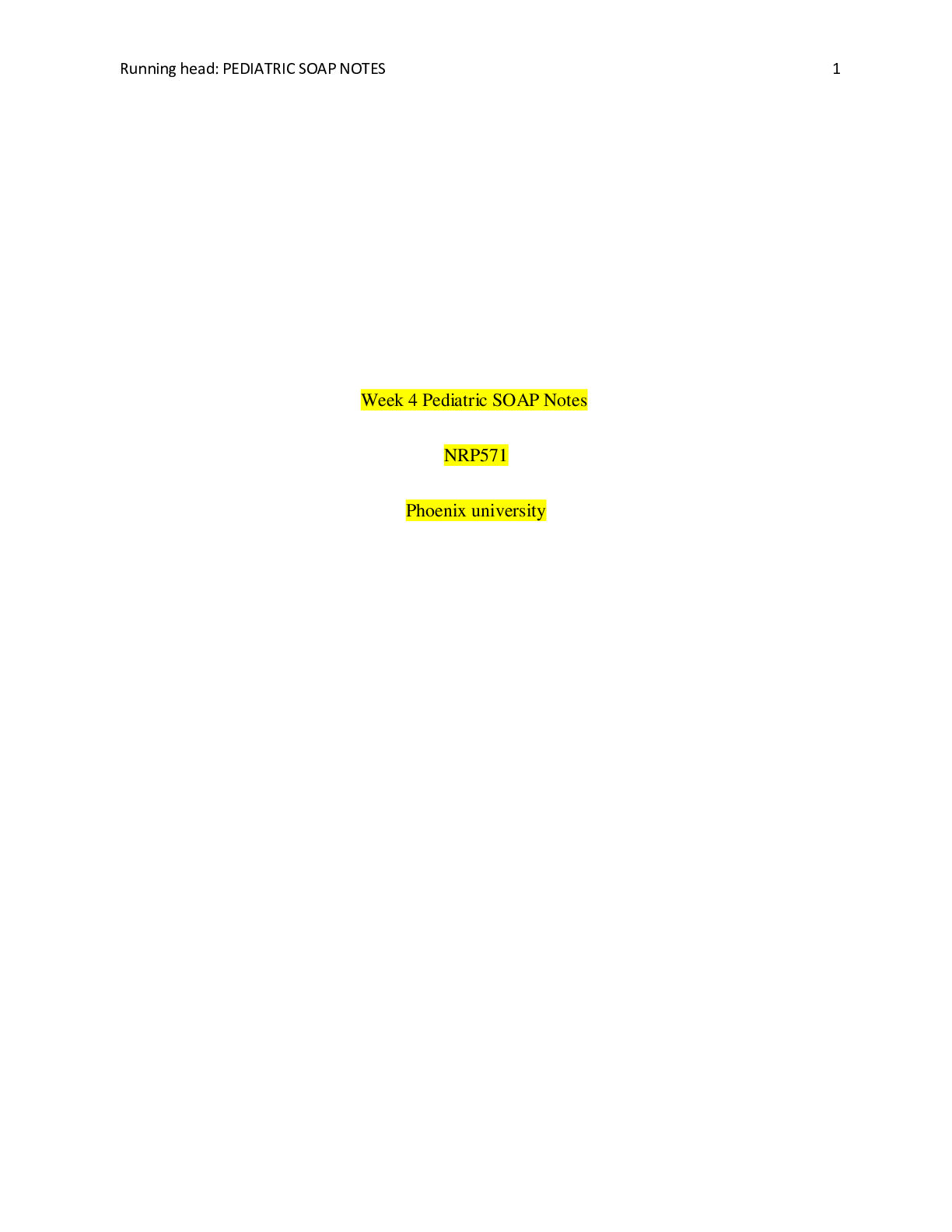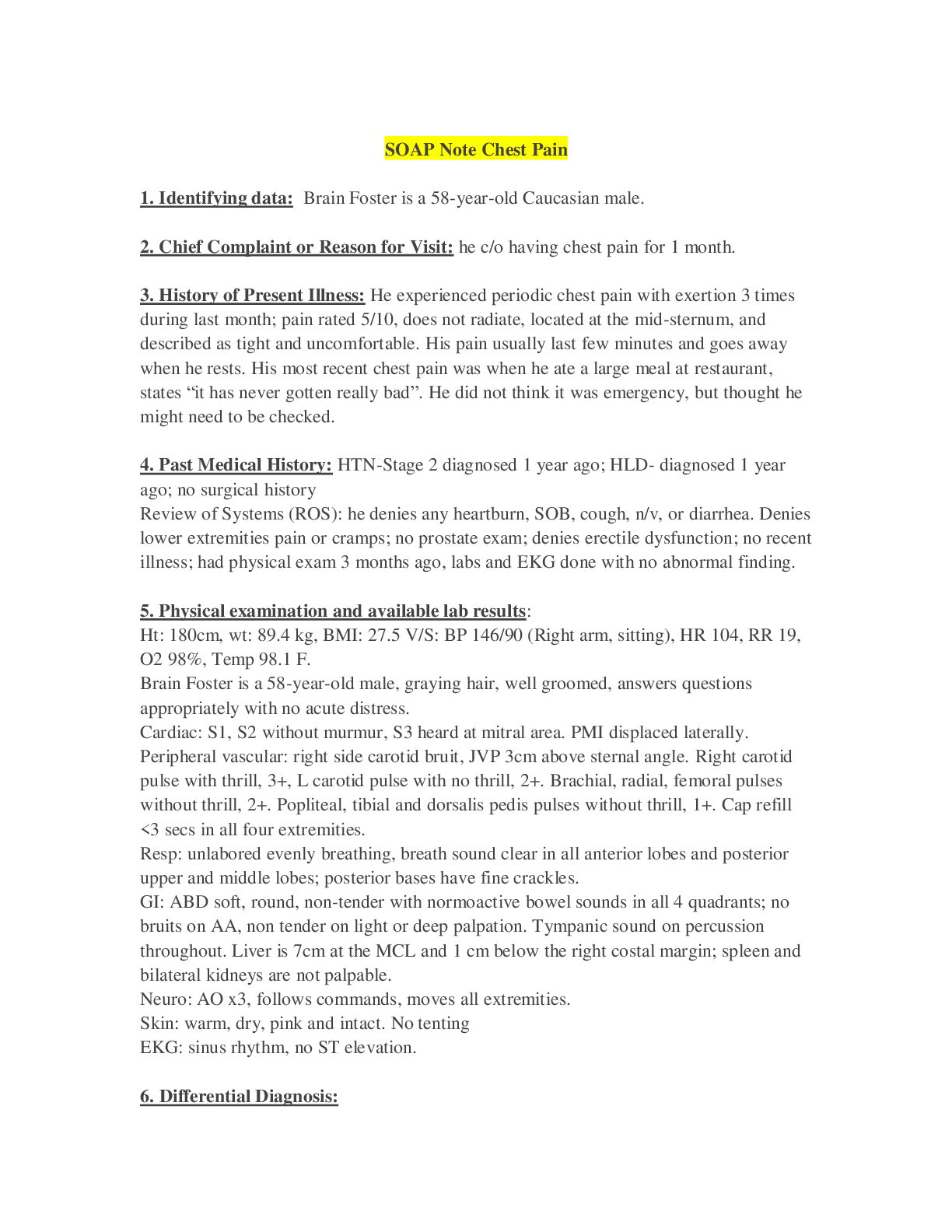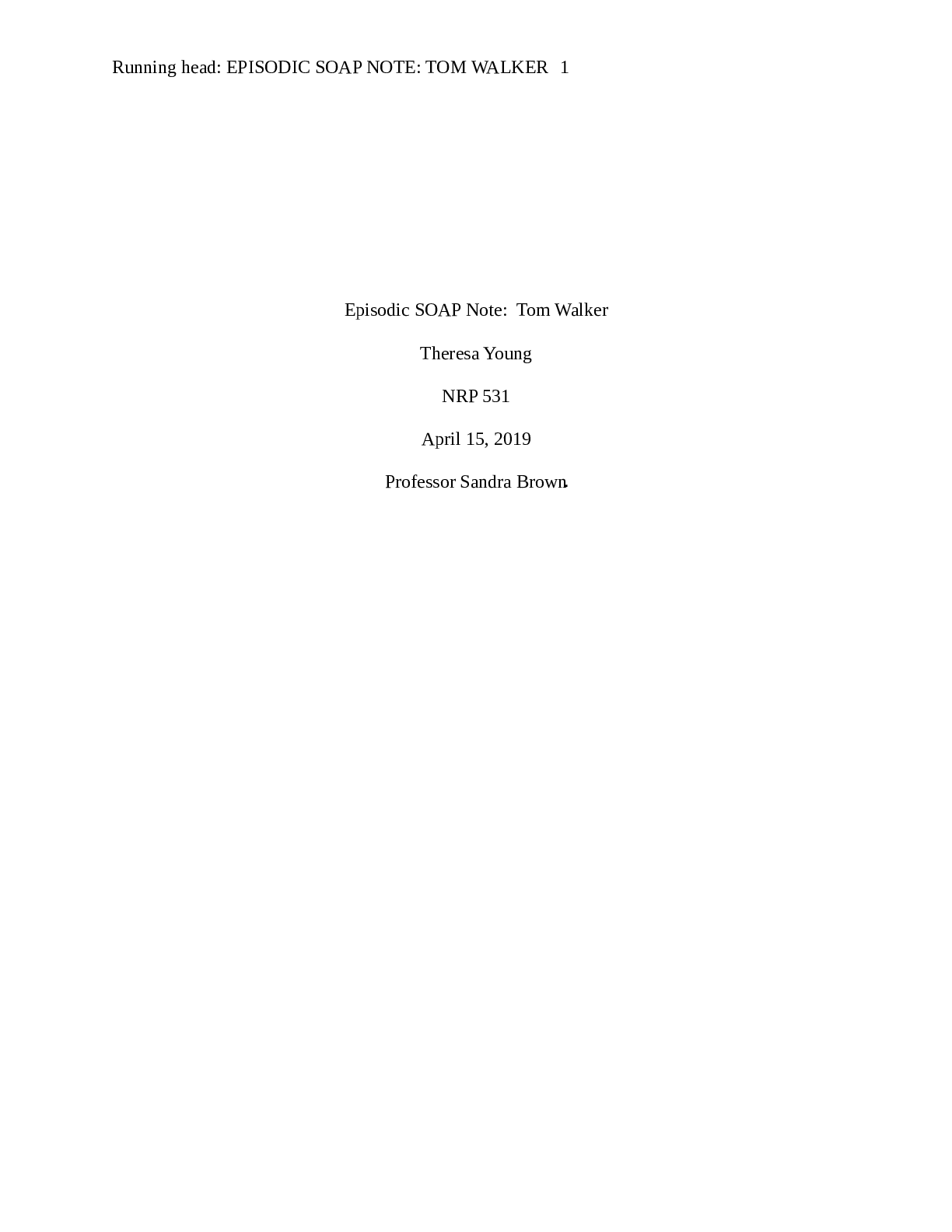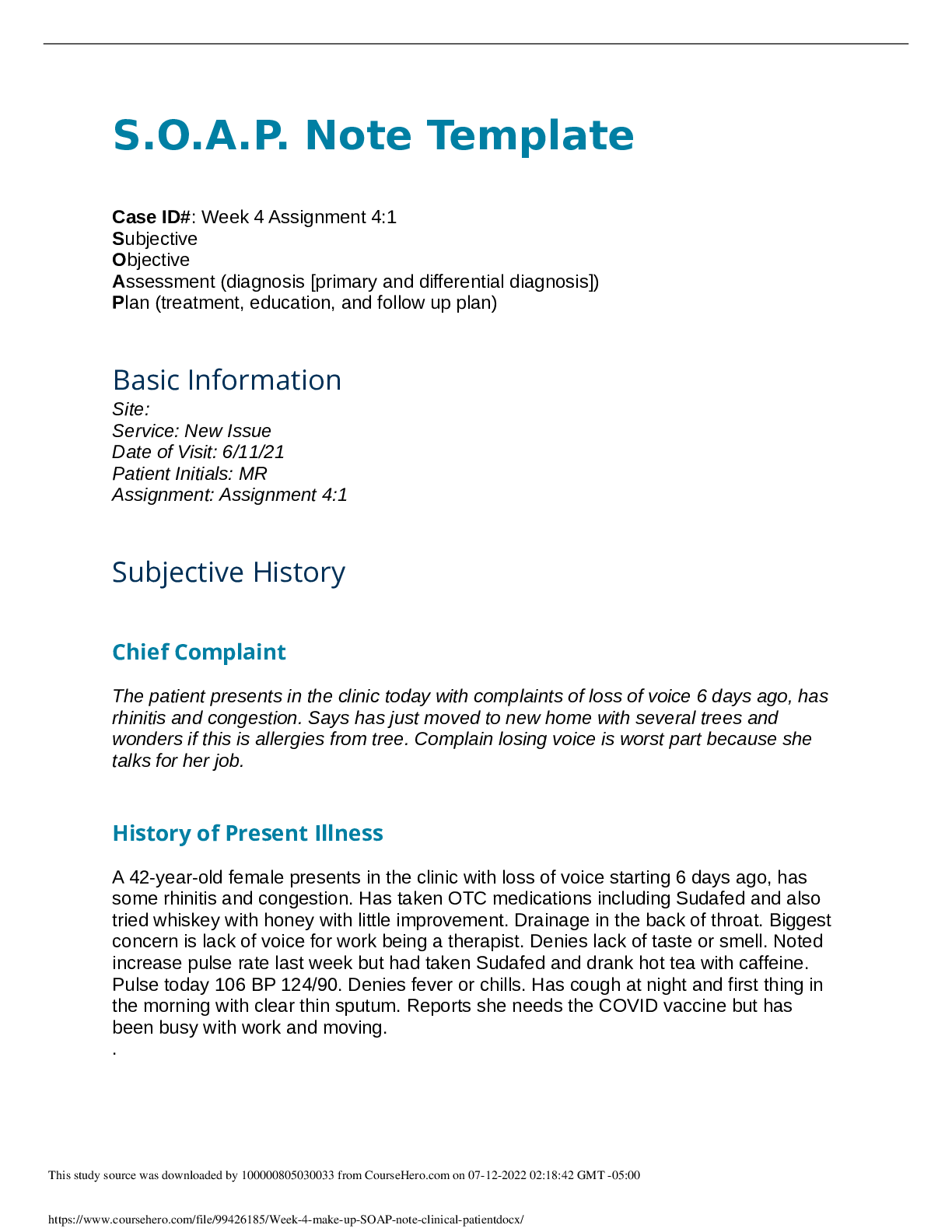*NURSING > SOAP NOTE > NRP571 Health assesment week 4 Pediatric soap notes (ANSWERED) | Graded A. (All)
NRP571 Health assesment week 4 Pediatric soap notes (ANSWERED) | Graded A.
Document Content and Description Below
Week 4 Pediatric SOAP Notes NRP571 Phoenix university Pediatric SOAP Note 1 Date: 15 July 2011 Name: C.P (Female) DOB: 15 August 2007 Age: 4 years 11 months CC: Here with father who ... is the informant; concerns about constipation Ht: 42” =3.5ft Wt: 44 lb/2.2=20kg HC: 38cm BMI:17.5 Temp :98 F(No fever) HR: 68(borderline bradycardia) Resp.: 24 Allergies: Sulfa, PCN HPI: CP is a 4-year-old and 11-month female. She will turn 5 next month. She is here with her father because of concerns of abdominal pain before having BM. Father reports that she feels better after defecating but denies soiling underwear. Location: Abdomen ,quality: patient describes a feeling of aching, severity: 4/10 on FACES pain scale, timing: symptoms started a week ago. Alleviating and aggravating factors: pain when trying to defecate then feel better after pooping. Dad has not tried any treatments. Patient had problems with BMs when she started in preschool last year but seemed to resolve with increased fluids. She has been toilet trained since she was three years old. She usually has one soft stool daily to every other day, but now she has BMs every 3 to 4 days, hard, large, brown in color. Last BM last night before bedtime. She is voiding well, denies any daytime or nighttime enuresis. Vaccines are up to date. PMH: No hospitalizations or surgeries. No recent illness. Passed meconium within first day of life. FH: Mother is 31 years old and father is 36 years old. Father reports no health problems for himself or the mom. Maternal grandmother is 51yo and has no known health problems. Maternal grandfather is 52yo and has HTN. Paternal grandmother is 58yo and has a history of high cholesterol on atorvastatin. Paternal grandfather is 62yo and has HTN on amlodipine. Meds: None. Allergies: Sulfa and PCN. No known food allergies or intolerances. No contrast dye allergies SH: Very social and likes to be with other children. Will start kindergarten in fall. In home with parents and a new 2-month-old baby brother. Stays home with mother. Father states she and the mother do not smoke. They drink alcohol occasionally. Patient does not drink caffeine. She can watch 2 hours of TV per day. ROS: Negative for bloody stools, weight loss, Nausea/Vomiting, fevers, ulcers in the mouth, jaundice, and enuresis. Constitutional symptoms-father reports concerns of abdominal pain before having BM. Father/patient deny difficulty sleeping, chills, malaise, night sweats, unexplained weight loss or weight gain. Eyes-Denies blurred vision, difficulty focusing, ocular pain, diplopia, scotoma, peripheral visual changes, and dry eyes. No corrective lenses. Father states date of last eye exam was in 2010 and exam was reported normal(20/20 vision). Ears, nose, mouth, and throat WNL. Dad reports no headaches, hoarseness, vertigo, sinus problems, epistaxis, dental problems, oral lesions, hearing loss or changes, nasal congestion. Date of last dental visit was about last month. Cardiovascular :Dad denies any history of heart murmur, chest pain, palpitations, dyspnea, activity intolerance, varicose veins, or edema. Respiratory: Denies history of respiratory infections, SOB, wheezing, difficulty breathing, exposure to secondary smoke, exposure to TB, hemoptysis. Gastrointestinal: Eats meals with family. Good appetite, about 2 to 3 6-ounce glasses of milk daily and she likes cut up fruits and vegetables. Normal ADLs- eating, drinking, sleeping well, voiding 4 to 6 times a day with no problem. Denies reflux, pyrosis, bloating, nausea, vomiting, diarrhea, constipation, hematemesis, abdominal or epigastric pain, hematochezia, change in bowel habits, food intolerance, flatulence, hemorrhoids. Genitourinary: Dad denies urgency, frequency, dysuria, suprapubic pain, nocturia, incontinence, hematuria, and history of stones. Musculoskeletal: Father denies back pain, joint pain, swelling, muscle pain or cramps, neck pain or stiffness, changes in ROM. She uses a booster chair and wears seatbelt. Integumentary: Dad denies itching, uritcaria, hives, nail deformities, hair loss, moles, open areas, bruising, and skin changes. mom applies sunscreen while outside and inspects her skin regularly for any changes. Neurologic: Dad denies headache, weakness, numbness, tingling, memory difficulties, involuntary movements or tremors, syncope, stroke, seizures, paresthesias. Psychiatric : Denies nightmares, mood changes, anxiety, depression, nervousness, insomnia, suicidal thoughts, exposure to violence, or excessive anger. Endocrine: Dad denies changes in skin, hair or nail texture, unexplained change in weight . Hematologic/lymphatic: Dad denies unusual bleeding or bruising, lymph node enlargement or tenderness, fatigue, history of anemia, blood transfusions. Allergic/immunologic: Dad denies seasonal allergies, allergy testing, exposure to blood or body fluids, use of steroids, or immunosuppression in self or family ( Bickley, 2017). Objective: General: Well appearing, well-nourished child in no acute distress. Neuro: Cranial nerves intact. DTRs +2. No sacral dimple, which reduces suspicion of neurological causes. Eyes: sclerae white. Conjunctivae pink. Pupils are PERRL, 4 mm bilaterally. Ear, Nose: external appearance normal no lesions, redness, or swelling; on otoscopic exam tympanic membranes clear, no redness, fluid, or bulging noted. Hearing is Intact . Appearance of nose normal with no mucous, inflammation or lesions present. Nares patent. Septum is midline. Mouth: pink, moist mucous membranes. No missing or decayed teeth. Cardiovascular: S1, S2. Regular rate and rhythm, no murmurs, gallops or rubs . Respiratory: Even and unlabored. Clear to auscultation bilaterally with no wheezes, rales, or rhonchi. Genitourinary : No bladder distention, suprapubic pain, or CVA tenderness. Abdomen: Hypoactive bowel sounds present in all quadrants. Abdomen slightly firm but, non-distended, and non-tender. No palpable masses or stool. Abdomen exam grossly normal. No signs of fecal impaction. Rectal : Good sphincter tone with no anal, perineal or rectal lesions. Rectal opening midline with no anal fissures. 1- When did your child first begin experiencing symptoms of constipation? documenting time of onset of constipation is important to rule out Hirschsprung disease which usually presents in the first few months of life with history of delay in the passage of meconium in the neonatal period and constipation ( Ali ., Ahmed ., Qadir., Humayun., & Ahmad, 2011). 2- How does this affect her social life(directing this question to dad)? The majority of cases of constipation and fecal incontinence are secondary to functional disorders, rather than organic causes and result in behavioral problems, which affect the social life of the child, as well as the family ( Ali ., Ahmed ., Qadir., Humayun., & Ahmad, 2011) 3- Have your child's symptoms been continuous or occasional? When stool stays too long in the colon, the colon absorbs too much fluid from the stool. Then the stool becomes hard, dry, and difficult to pass ( Ali ., Ahmed ., Qadir., Humayun., & Ahmad, 2011). 4- Do you see blood with your child's bowel movements, either mixed in with the stool, in the toilet water or on the toilet paper? Painless rectal bleeding is the leading clinical manifestation reported in children, occurring in approximately 31% to 34% of symptomatic Meckel’s diverticuli (Wentlandt., & Beck, 2007). 5- Do you stop using the bathroom because it hurt so much(direct to the child)? Once a child becomes constipated, the problem can quickly get worse. Hard, dry stools can be painful to push out. So, the child may stop using the bathroom because it hurts. Over time, the colon will not be able to sense that stool is there (The Johns Hopkins University, 2019) Tests/Rationales: The BMI is 17.5, placing the BMI-for-age at the 92th percentile for girls aged 4 years 11 months which means she is overweight ( CDC,2019). Rectal examination was performed, assessing rectal tone to rule out neurological compromise and to feel for the presence of hard or impacted stool. The rectal exam can also reveal the presence or absence of internal or external hemorrhoids which she does not have. Ultrasound, magnetic resonance imaging, and computed tomography are advantageous in identifying lesions such as an obstruction that contribute to constipation. The abdominal X-ray test allows us to see if there are any blockages in your child's abdomen. Beside the Abdominal x-ray, we can also do Barium enema X-ray. In this test, the lining of the bowel is coated with barium so that the rectum, colon and sometimes part of the small intestine can be clearly seen on an X-ray. complete blood count to look for anemia . The anorectal manometry or motility test which is a thin tube called a catheter is placed in the rectum to measure the coordination of the muscles your child uses to pass stool ( Seattle Children’s Hospital, 2019). ICD-10 codes and E&M codes: K59.0 Constipation. R10.9 for abdominal pain. G0102 for rectal exam. Barriers: The biggest barrier here is that the patient is a child . It is very important for the NP to communicate effectively with the family, the care-givers, and the patient despite the pediatric age, in order to obtain a full compliance regarding the treatment, and therefore the patient's outcome ( Mărginean ., Meliţ ., Chinceşan ., Mureşan ., Georgescu ., Suciu, N., … Azamfirei, 2017). The fact that the history says that the patient stays home with mom and is here with dad make me think that dad may not know all the details about her symptoms. A recent study shows that Professionals who care for children and families need to explore creative ways to engage fathers in the structured health care of their children. For example, pediatricians can stress the benefits of both parents being involved in their child's health care ( Garfield, 2006). Pediatric SOAP Note 2 Name: D. P. Date: 15 July 2011 DOB: 10 June 1995 Gender: Female Age: 16 years CC: Concerned about D. P’s weight Ht:68 ½” % Wt: 230 lb=105kg HC: NA BMI 34.5 (obese) Temp. 98 HR: 86 Resp.: 20 Allergies: NKDA HPI: D.P is a new patient. She is today with mother who is the informant . Mother is concerned about her weight. Patient has not received regular well exams due to lack of insurance. Last well exam was when she was 12-years old, but she has insurance coverage now. Vaccines are up to date except for recommended HPV series. Mother and D. P. would like to start vaccine series today. Menses started at 12 years of age. Has regular menses monthly lasting about 4 to 5 days, no discomfort. Normal developmental milestones. PMH: No known medical problems but has been overweight “all her life”. Denies previous serious illness or surgery. Denies prescription medication. Takes daily multivitamins. No regular use of OTC, herbal or other supplements. No drug or other allergies SH: No regular exercise and denies being sexually active. Will be starting 11th grade in the fall. Grades usually As and Bs. Just moved to Arizona. Has made a few friends in the neighborhood. She likes to read, hangs out with friends, takes singing lessons, and would like to sing professionally. FH: Lives with both parents, 2 sisters, and older brother. Family members are also obese per mother and D.P. Grandparents, Siblings, father and mother are both healthy . No known cancer, strokes, heart disease. ROS: Denies chest pain, dyspnea on exercise/at night, swelling ankles, cough or wheeze. No abdominal pain, nausea, vomiting, indigestion. Menarche aged 12, regular cycles 4 to 5 days without cramps, clots or intermenstrual bleeding/spotting. LMP last week July 8th. No discharge, genital lesions, dyspareunia, pelvic pain. Denies difficulty sleeping, chills, malaise, night sweats, or unexplained weight loss . Denies blurred vision, difficulty focusing, ocular pain, diplopia, scotoma, peripheral visual changes, and dry eyes. No glasses or contacts. Ears, nose, mouth, and throat normal. Patient denies headaches, hoarseness, vertigo, sinus problems, epistaxis, dental problems, oral lesions, hearing loss or changes, nasal congestion. No recent dental checkup. Patient and mom deny any history of heart murmur, chest pain, palpitations, dyspnea, activity intolerance, varicose veins, edema. Denies history of respiratory infections, SOB, wheezing, difficulty breathing, exposure to secondary smoke, exposure to TB, hemoptysis. Gastrointestinal: ADLs are WNL. She eats and sleeps well. Normal void with last BM this morning . Denies reflux, pyrosis, bloating, nausea, vomiting, diarrhea, constipation, hematemesis, abdominal or epigastric pain, hematochezia, change in bowel habits, food intolerance, flatulence, hemorrhoids. Denies urgency, frequency, dysuria, suprapubic pain, nocturia, incontinence, hematuria, history of stones. Denies back pain, joint pain, swelling, muscle pain or cramps, neck pain or stiffness, changes in ROM. Denies itching, uritcaria, hives, nail deformities, hair loss, moles, open areas, bruising, and skin changes. Denies headache, weakness, numbness, tingling, memory difficulties, involuntary movements or tremors, syncope, stroke, seizures, paresthesias. Denies nightmares, mood changes, anxiety, depression, nervousness, insomnia, suicidal thoughts, exposure to violence, or excessive anger. Denies cold or heat intolerance, polydipsia, polyphagia, polyuria, changes in skin, hair or nail texture, changes in facial or body hair. Denies unusual bleeding or bruising, lymph node enlargement or tenderness, fatigue, history of anemia, blood transfusions. Objective: General appearance: Patient is obese but well developed, well nourished, alert and cooperative Mental: Patient is awake alert and oriented to time place and person. Patient is not suicidal. No abnormal behaviors during the examination. Neurological: CN 1-12 intact. Strength and sensation symmetric. Reflexes 2+ throughout. Head & Neck: Normocephalic . Neck supple, non-tender without lymphadenopathy, masses or thyromegaly. No Swelling in the lymph nodes. Full active cervical range of motion. Thyroid grossly within normal limits to inspection which rule out part of thyroid issues. Eyes: Orbits, eyelids, conjunctivae and sclera are normal. Pupils are equal, round, reactive to light with extraocular movements intact. Vision is grossly intact, and funduscopic examination is unremarkable. The external brows, lids, and artificial lashes are intact with no drainage. Distance visual acuity to measure image at 6 meters using the standard Snellen chart ( Bickley, 2017). Ears: Normal appearing external structures. No deformities, no edema, and no drainages or purulence noted. External auditory canals and tympanic membranes translucent. brownish earwax present. The eardrum is shiny pearly-white color (U.S. National Library of Medicine, 2019). Nose: nasal mucosa pink, without swelling or tenderness. No polyps or nasal discharge noted. No tenderness over the frontal or maxillary sinuses (Bickley, 2017). Mouth/Throat: Normal oral cavity and tongue size. No mass no hypertrophy or deformity. Normal uvula and pharynx . No inflammation, swelling, exudate, or lesions. Chest & lungs: Respirations 20 regular and unlabored. Lungs clear to auscultation and percussion without rales, rhonchi, wheezing or diminished breath sounds. No cough, or dyspnea. Respirations 18 regular. Good excursions. No dullness on percussion . Chest is symmetrical . Cardiovascular: Normal S1 and S2. No S3, S4 or murmurs. No chest pain/discomfort with palpations and no edema noted . Abdomen: soft and obese. +BS in all four quadrants. No tenderness upon palpation. No masses, no herniation or abnormal pulsations noted ( Bickley, 2017). Musculoskeletal: Moves upper and lower extremities without any complaint of pain. no instability, no limitation. Upper extremity muscle strength is normal bilaterally. Sensation is normal bilaterally. Reflexes: normal and symmetric at biceps, triceps, brachioradialis. Extension, flexion and rotation normal . No spinal deformity, symmetry of spinal muscles, without tenderness, decreased range of motion or muscular spasm ( Bickley , 2017). Skin/Hair/Nails: Skin normal color, texture and turgor /warm and dry. No jaundice noted. No open cuts, draining sores or bruises noted. Normal distribution of blonde hair on scalp and perineum. No detachment of nail plate ( Bickley, 2017). Genitourinary female exam: Normally developed genitalia with no external lesions or eruptions. Vagina and cervix show no lesions, inflammation, discharge or tenderness ( Bickley, 2017). Pelvic exam deferred because pt is not sexually active. Tests: We can check the ESR which is a test that indirectly measures the degree of inflammation present in the body because this test measures the sedimentation of erythrocytes in a sample of blood. We will check TSH to see the level of her T4 and T3. Her unexplained change in weight is one of the most common signs of a thyroid disorder. Depends on the result of her TSH we can proceed to do an ultrasound of the thyroid closer at the thyroid nodules and rule out hashimoto’s disease and Hypothyroidism ( NIDDK,2019). The A1C test can indicates her average blood sugar level for the past two to three months to rule out childhood diabetes. We need to check LDL , HDL, and Triglycerides to rule out cholesterol because of her unhealthy lifestyle. The BMI is 34.5, placing the BMI-for-age at the 98th percentile for girls aged 16 years. This child has obesity. Vitamin D level because low vitamin D levels can also cause a poorly functioning immune system, cardiovascular disease, depression, development of diabetes, and multiple sclerosis. 1. What does your child eat in a typical day(talking to mom)? Mom should Offer planned meals and snacks consistently throughout the day. A good rule of thumb is to offer snacks a few hours after one meal ends and about one to two hours before the next meal begins ( Shield, 2019) 2. How much activity does your child get in a typical day? A study conducted by researchers from the Johns Hopkins Bloomberg School of Public Health, shows that by the end of adolescence, activity levels were alarmingly low. The only age group with an increase in activity is young adults in their 20s ( Children's Health Team, 2018). 3. What factors do you believe affect your child's weight? Eating and drinking a lot of foods and beverages that are high in calories, sugar, and fat. drink a lot of beverages that are high in added sugars. spend a lot of time sitting or lying down and have limited physical activity( NIDDK, 2019). 4. What diets or treatments, if any, have you tried to help your child lose weight? Children should not be placed on a weight reduction diet without the consultation of a health care provider. The goal is to involve the whole family in building healthy eating, drinking, and physical activity habits. Everyone benefits, and your child who is overweight won’t feel singled out ( NIDDK, 2019). 5. Are you ready to make changes in your family's lifestyle to help your child lose weight? Since the whole family is on the bigger side. I want to know how determined the mother is about eating healthy and help the child food good diet to lose the weight. Mom should be ready help not only the patient but also the other siblings to learn to be aware of what they eat by developing healthy eating habits, looking for ways to make favorite dishes healthier, and reducing calorie intake ( CDC, 2019). Codes: Z68.54 for childhood obesity. Z00.129 for routine exam. Z00-Z99 for diabetic screening. Z13.220 for screening for lipoid disorders ( CDC,2019). Barriers: The patient is an adolescent and her mom are present so she may be shy and feels that her confidentiality is being compromised. In this case the NP has to follow the state protocol as it is. This patient underage and mom has to stay in the room. A study shows that Adolescents with concerns about confidentiality are more likely to forgo health-care services, particularly with regard to sexual and reproductive health ( Fuentes ., Ingerick., Jones., & Lindberg, 2018). Another barrier is the fact that mom refused the HPV vaccine because she thinks she may not be able to wage the co pays for the visit and the other tests. The NP should refer this patient to the social worker to balance the options for coverage. One of the main goals of the healthy people 2020 is to encourage everyone about the need for healthcare . Access to comprehensive, quality health care services is important for promoting and maintaining health, preventing and managing disease, reducing unnecessary disability and premature death, and achieving health equity for all Americans( Healthy People, 2019). References Ali, S. R., Ahmed, S., Qadir, M., Humayun, K. N., & Ahmad, K. (2011). Fecal incontinence and constipation in children: a clinical conundrum. Oman medical journal, 26(5), 376–378. doi:10.5001/omj.2011.94. retrieved from https://www.ncbi.nlm.nih.gov/pmc/articles/PMC3215436/ Bickley, L. S., & Szilagyi, P. G. (2017). Bates’ guide to physical examination and history taking (12th ed.). Retrieved from https://phoenix.vitalsource.com/#/books/9781496354709/cfi/4!/4/[email protected]:0.00 Centers for Disease Control and Prevention (2019). BMI Percentile Calculator for Child and Teen: Results. Retrieved from https://www.cdc.gov/healthyweight/bmi/result.html? &method=english&gender=f&age_y=4&age_m=11&hinches=42&twp=44#whatDoesItMean Centers for Disease Control and Prevention (2019). Tips for Parents–Ideas to Help Children Maintain a Healthy Weight. Retrieved from https://www.cdc.gov/healthyweight/children/index.html Centers for Disease Control and Prevention (2019). International Classification of Diseases, Tenth Revision, Clinical Modification (ICD-10-CM). Retrieved from https://www.cdc.gov/nchs/icd/icd10cm.htm Children's Health Team. (2018, December 26). Teens Get Less Exercise Than the Average 60-Year-Old. Retrieved from https://health.clevelandclinic.org/study-teens-get-less-exercise- than-the-average-60-year-old/ NIDDK. (2019, September 17). Factors Affecting Weight & Health. Retrieved September 17, 2019, from https://www.niddk.nih.gov/health-information/weight-management/adult- overweight-obesity/factors-affecting-weight-health Fuentes, L., Ingerick, M., Jones, R., & Lindberg, L. (2018). Adolescents' and Young Adults' Reports of Barriers to Confidential Health Care and Receipt of Contraceptive Services. The Journal of adolescent health : official publication of the Society for Adolescent Medicine, 62(1), 36–43. doi:10.1016/j.jadohealth.2017.10.011. Retrieved from https://www.ncbi.nlm.nih.gov/pmc/articles/PMC5953199/ Garfield, C. F. (2006). Fathers and the Well-Child Visit. Pediatrics, 117(4). doi: 10.1542/peds.2005-1612. Retrieved from https://www.ncbi.nlm.nih.gov/pubmed/16585280 Healthy people ( 2019). Access to Health Services. Retrieved from https://www.healthypeople.gov/2020/topics-objectives/topic/Access-to-Health-Services Mărginean, C. O., Meliţ, L. E., Chinceşan, M., Mureşan, S., Georgescu, A. M., Suciu, N., … Azamfirei, L. (2017). Communication skills in pediatrics - the relationship between pediatrician and child. Medicine, 96(43), e8399. doi:10.1097/MD.0000000000008399 . Retrieved from https://www.ncbi.nlm.nih.gov/pmc/articles/PMC5671869/ Seattle Children’s Hospital (2019). Constipation. Retrieved from https://www.seattlechildrens.org/conditions/a-z/constipation/ Shield, J.E (2019). When Should My Kids Snack?. Retrieved from https://www.eatright.org/food/nutrition/dietary-guidelines-and-myplate/when-should-my-kids- snack The National Institute of Diabetes and Digestive and Kidney Diseases Health Information Center (2019). Thyroid Tests. Retrieved from https://www.niddk.nih.gov/health- information/diagnostic-tests/thyroid The Johns Hopkins University (2019). Constipation in Children. Retrieved from https://www.hopkinsmedicine.org/health/conditions-and-diseases/constipation-in-children Wentlandt, K., & Beck, C. E. (2007). Case 1: A child with gastrointestinal bleeding. Paediatrics & child health, 12(10), 869–870. doi:10.1093/pch/12.10.869. Retrieved from https://www.ncbi.nlm.nih.gov/pmc/articles/PMC2532564/ [Show More]
Last updated: 1 year ago
Preview 1 out of 16 pages

Reviews( 0 )
Recommended For You
*NURSING> SOAP NOTE > NRP 531Tom Walker, Episodic SOAP Note: Already graded A. (All)

NRP 531Tom Walker, Episodic SOAP Note: Already graded A.
Episodic SOAP Note: Tom Walker|NRP 531,Latest 2020 complete, Already graded A.
By Expert1 , Uploaded: Jul 18, 2020
$10
*NURSING> SOAP NOTE > NURS 112 SOAP Note Chest Pain Pennsylvania State University -Download To Score An A (All)

NURS 112 SOAP Note Chest Pain Pennsylvania State University -Download To Score An A
SOAP Note Chest Pain 1. Identifying data: Brain Foster is a 58-year-old Caucasian male. 2. Chief Complaint or Reason for Visit: he c/o having chest pain for 1 month. 3. History...
By Succeed , Uploaded: Aug 03, 2020
$9.5
Health Care> SOAP NOTE > SOAP Note: Cardiovascular Patient: Liam Fitzgerald SUBJECTIVE CC: “Routine follow up for his chronic conditions” (All)

SOAP Note: Cardiovascular Patient: Liam Fitzgerald SUBJECTIVE CC: “Routine follow up for his chronic conditions”
HPI: Mr. Fitzgerald is a 66-year-old male who presents via telehealth for a routine follow up on his chronic heart failure. He provided verbal consent for this telehealth visit. Mr. Fitzgerald repor...
By STUDY-GUIDENOTES , Uploaded: Oct 05, 2022
$7
Health Care> SOAP NOTE > Caroline Casey SOAP (All)

Caroline Casey SOAP
Caroline Casey SOAP
By Ellen Ronald , Uploaded: Jul 29, 2022
$8
Health Care> SOAP NOTE > Episodic SOAP Note: Tom Walker|NRP 531,Latest2019/ 2020 complete, Already graded A (All)

Episodic SOAP Note: Tom Walker|NRP 531,Latest2019/ 2020 complete, Already graded A
Running head: EPISODIC SOAP NOTE: TOM WALKER 1 Episodic SOAP Note: Tom Walker NRP 531 2021 Professor Sandra Brown EPISODIC SOAP NOTE: TOM WALKER 2 DOS: 4/15/2019 ID: Tom Walker (M) DOB: 6/28/73 (45) C...
By Nancylect , Uploaded: Jul 20, 2022
$9
Health Care> SOAP NOTE > Episodic SOAP Note: Tom Walker|NRP 531,Latest 2019/ 2020 complete, Already graded A (All)

Episodic SOAP Note: Tom Walker|NRP 531,Latest 2019/ 2020 complete, Already graded A
Running head: EPISODIC SOAP NOTE: TOM WALKER 1 Episodic SOAP Note: Tom Walker NRP 531 2021 Professor Sandra Brown EPISODIC SOAP NOTE: TOM WALKER 2 DOS: 4/15/2019 ID: Tom Walker (M) DOB: 6/28/73 (45) C...
By MARKALLAN , Uploaded: Jul 20, 2022
$9
*NURSING> SOAP NOTE > Episodic SOAP Note: Tom Walker|NRP 531,Latest 2020 complete, Already graded A (All)

Episodic SOAP Note: Tom Walker|NRP 531,Latest 2020 complete, Already graded A
Running head: EPISODIC SOAP NOTE: TOM WALKER 1 Episodic SOAP Note: Tom Walker NRP 531 2021 Professor Sandra Brown EPISODIC SOAP NOTE: TOM WALKER 2 DOS: 4/15/2019 ID: Tom Walker (M) DOB: 6/28/73 (45) C...
By Prof.Pierro , Uploaded: Jul 20, 2022
$9
*NURSING> SOAP NOTE > ADULT 620 Week 4 make up SOAP note clinical patient (All)

ADULT 620 Week 4 make up SOAP note clinical patient
ADULT 620 Week 4 make up SOAP note clinical patient Chief Complaint The patient presents in the clinic today with complaints of loss of voice 6 days ago, has rhinitis and congestion. Says has just...
By Topmentor , Uploaded: Jul 12, 2022
$10
*NURSING> SOAP NOTE > BACTERIAL VAGINOSIS SOAP NOTE (All)
.png)
BACTERIAL VAGINOSIS SOAP NOTE
BACTERIAL VAGINOSIS SOAP NOTE KL is a 25-year old female of a Caucasian decent
By Topmentor , Uploaded: Jul 12, 2022
$10
*NURSING> SOAP NOTE > Week 6 SOAP note Patient Initials P.R. A 94 year old female (All)

Week 6 SOAP note Patient Initials P.R. A 94 year old female
Week 6 SOAP note Patient Initials P.R. A 94 year old female Chief Complaint Follow-up from last week on peri-area rash. Patient states was in the hospital with a catheter, then in rehab was given ‘...
By Topmentor , Uploaded: Jul 12, 2022
$10
Document information
Connected school, study & course
About the document
Uploaded On
Oct 17, 2021
Number of pages
16
Written in
Additional information
This document has been written for:
Uploaded
Oct 17, 2021
Downloads
1
Views
103






